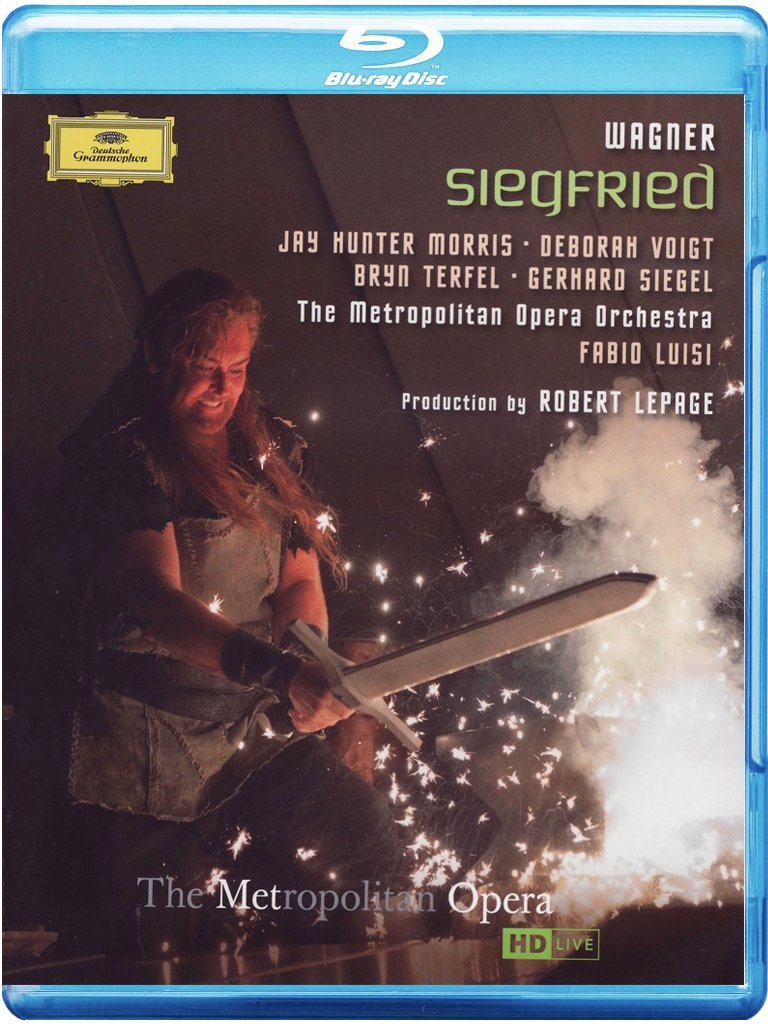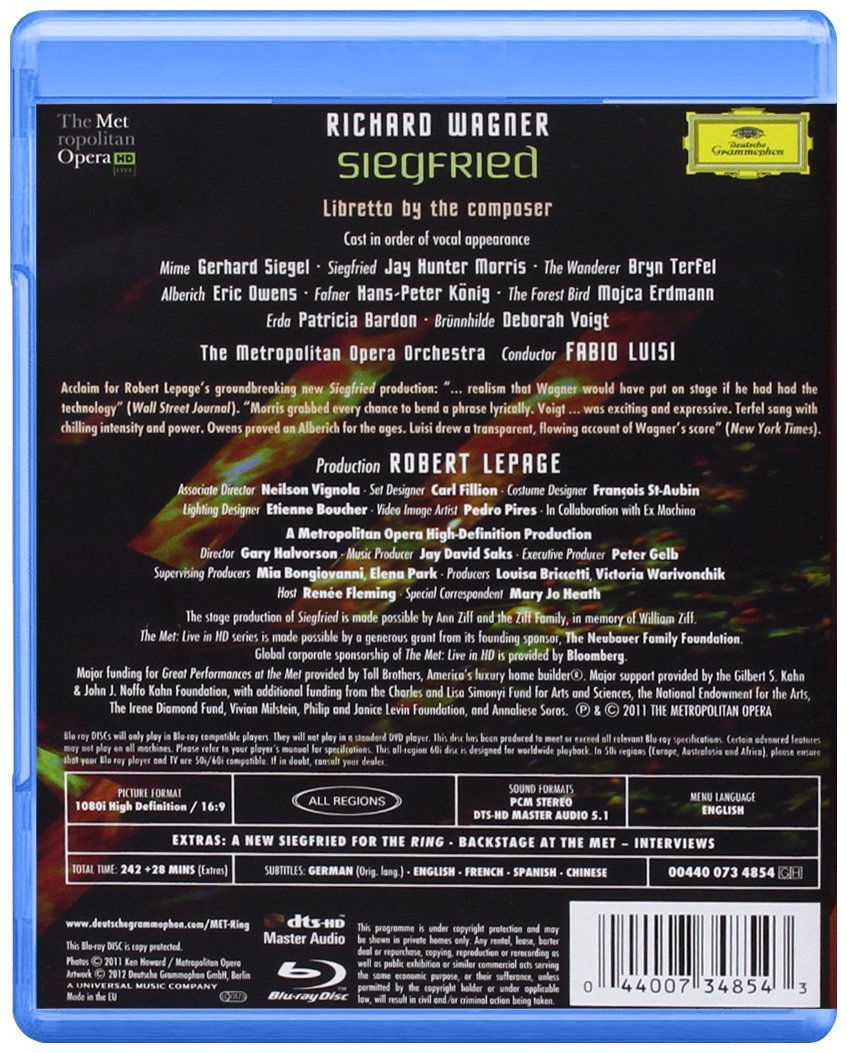

Wagner Siegfried opera. Directed 2011 by Robert Lepage. Stars Gerhard Siegel (Mime), Jay Hunter Morris (Siegfried), Bryn Terfel (The Wanderer), Eric Owens (Alberich), Hans-Peter König (Fafner), Mojca Erdmann (The Forest Bird), Patricia Bardon (Erda), and Deborah Voigt (Brünnhilde). Fabio Luisi conducts the Metropolitan Opera Orchestra. Associate Direction by Neilson Vignola; set design by Carl Fillion; costume design by François St.-Aubin; lighting design by Etienne Boucher; video image art by Pedro Pires in collaboration with Ex Machina. Directed for TV by Gary Halvorson; music produced by Jay David Saks. Sung in German. Supervising Producers were Mia Bongiovanni and Elena Park; Producers were Louisa Briccetti and Victoria Warivonchik. Released 2012, disc has 5.1 dts-HD Master Audio sound. Grade: A+
Note that this disc is also available in the Ring des Nibelungen box set published by Deutsche Grammophon. Before you read the mini-review below for Siegfried, you might read our write-up for entire Met Ring set.
This is the third of the four operas in the Wagner Ring. The mighty Met was able to keep all the same fine singers on board who appeared as various characters earlier in Das Rheingold and Die Walküre. This is a big help to a newcomer to the Ring. For example, I got to know Bryn Terfel well as Wotan in the earlier operas; when he shows up as the Wanderer in Siegfried, I instantly know that this is Wotan in human disguise.
In addition to our old friends, we have two new characters: a Forest Bird (sung off-stage) and Siegfried. Of all the soprano singers in the world, the Met picked Mojca Erdmann to be the voice of the bird. We know Mojca from her portrayal of Blonde in Die Entführung aus dem Serail. We also know Jay Hunter Morris, the Siegfried in this production, from his role as Captain Nolan in Doctor Atomic.
The Met originally cast Gary Lehman as Siegfried. But 8 days before the opening, the ill Lehman and Met management jointly decided to let Morris have the part. Morris had sung Siegfried as star with the San Francisco Opera and had been understudy for the role twice before serving as understudy at the Met. He was ready for his big break and took full advantage of it. He seems so obviously great in the role as singer and actor that you wonder why it took so long for the Met to star him. I live in Dallas, not far from Morris' home in Paris, Texas. The sweet Texas twang used by Morris in his extra interviews is exactly the way the natives around here talk. It's endearing to learn a bit about Morris' path from gospel singing at the Baptist Church to his celebrity as heldentenor. And is it too outlandish to wonder whether Morris' real career has to some degree been infused by the spirit of Siegfried's adventures as imagined by Wagner?
As in the earlier installments of the Ring, Lepage uses the resources of "the machine" and his video projectors in a conservative way to support (rather than upstage) the singer/actors in their old-fashioned story-telling. Most of this opera takes place at night or in the depths of a dark forest. Lepage provides a foreboding, creepy atmosphere that makes Siegfried's eventual assault on the wall of flames seem all the more heroic.
PQ and video content are excellent. Still there is one tech problem that should be mentioned now. Because the singers are between the machine and the video projectors, the images projected by the cameras shine on the singers in a way that is sometimes noticeable to the viewer. The best way to overcome this is to use tightly focused spotlights on the singers who are the center of attention; the spots wash out the video projections on the singers. Some camera angles tend to hide the images better than others. Also, the more I watch this series, the less these artifacts bother me. I think in time my brain learns to ignore them.
The orchestra plays very well for the new conductor, Fabio Luisi. SQ and balance between the orchestra and the singers is excellent. And the subtitles are so natural that I hardly remember them being there. For splendid general excellence, I'll give this production the same A+ grade I gave to Das Rheingold and Die Walküre.
So now we leave hero Siegfried in love with his half-aunt Brünnhilde. (Did I get the relationship right?) Well, in Western civilization, the marriage of uncles and nieces has been tolerated when necessary for political or land-owning purposes. But still, I don't think things are going to work out all that well for Siegfried and his new bride.